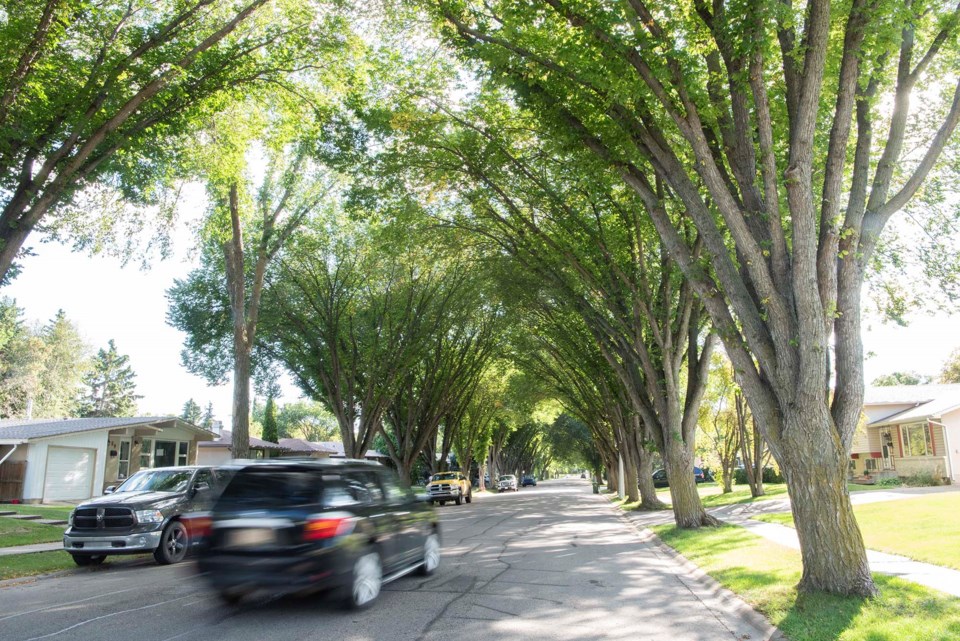St. Albert arborists are on high alert this month after a disease that could wipe out 11 per cent of the city’s trees was spotted next door in Edmonton.
The City of Edmonton announced Sept. 3 that it had detected Dutch elm disease (DED) in four trees in the Killarney and Yellowhead Corridor East neighbourhoods (which are near Hwy. 28 and Yellowhead Trail). It was the first time that the disease had ever been spotted in the city or the Edmonton region.
The disease is caused a fungus transported by three species of bark beetle that plugs up the water transport systems of elms, killing them, said certified arborist Jim Hole (former co-owner of Hole’s Greenhouses in St. Albert). It’s been spreading west across North America since the 1970s, wiping out elm populations as it goes.
City of Edmonton infrastructure operations director Mark Beare said crews spotted symptoms of the disease in early August. Lab tests confirmed it in four trees by Aug. 29.
Beare said Edmonton had the largest population of DED-free elms in the world prior to August, with some 90,000 elms in its inventory (about 22 per cent of the city’s canopy). Some streets are lined entirely with elm trees.
“Having Dutch elm disease pass through some of those communities would be absolutely devastating to the streetscape and the neighbourhood they currently know,” he said.
The DED fungus has yet to show up in St. Albert, but a few of the beetles known to carry it show up regularly in the city’s sticky traps, said City of St. Albert parks operations supervisor Erin Pickard. About 11 per cent of the city’s public trees (some 7,100 trees worth $170 million) are elms.
Pickard said DED kills infected elms within two years. Given its rate of spread, it’s only a matter of time before it gets here.
“It was Edmonton 2024. It could be St. Albert 2025,” Pickard said.
Stopping DED
Beare said DED likely came to Edmonton via beetle-infested firewood, which is its typical vector. He said it was hard to say how easily the disease could spread to St. Albert from Edmonton. Crews have destroyed the infected elms in Edmonton and were monitoring other elms in the region.
Pickard said city crews use traps and inspections to monitor for DED and the beetles that transmit it. Crews have stepped up monitoring following the Edmonton outbreak, and were encouraging people to learn to identify infected elms.
Elm trees have straight trunks, double-serrated leaves, deep-grooved silver-grey bark, and umbrella-like canopies. (See Forest Drive for an example of said canopy.) St. Albert’s elm are most heavily concentrated in North Ridge, Erin Ridge North, Sturgeon Heights, Braeside, the east side of Grandin, and Forest Lawn, the city’s online tree inventory suggests.
Symptoms of DED include red or dark brown streaks in elm wood and leaves on an elm branch that suddenly turn yellow, then brown, and shrivel without dropping off, the province reports. Leaves might also turn yellow and drop prematurely. Pickard encouraged residents to call the Stop Dutch Elm Disease Society (STOPDED) Hotline at 1-877-837-3567 if they spot an elm with disease symptoms.
The main way to stop the spread of DED was to not move firewood between regions, Beare said.
“Burn it where you buy it.”
Hole said it was also vital to respect the city’s anti-DED bylaw, which bans pruning of elms between April 1 and Sept. 30 without written permission from the city. That’s when the beetles that transmit it are active, and when wounds from pruning draw them to elms “like a beacon.” Elm wood must be disposed of in the designated area at the Mike Mitchell Recycling Depot for incineration.
Evidence from past outbreaks in Alberta suggests that the beetles that transmit this disease spread slowly, and can be contained if infested trees are destroyed early, said City of St. Albert senior manager of operations Louise Stewart.
“There’s no need to panic.”
Visit www.alberta.ca/dutch-elm-disease for details on the disease.




